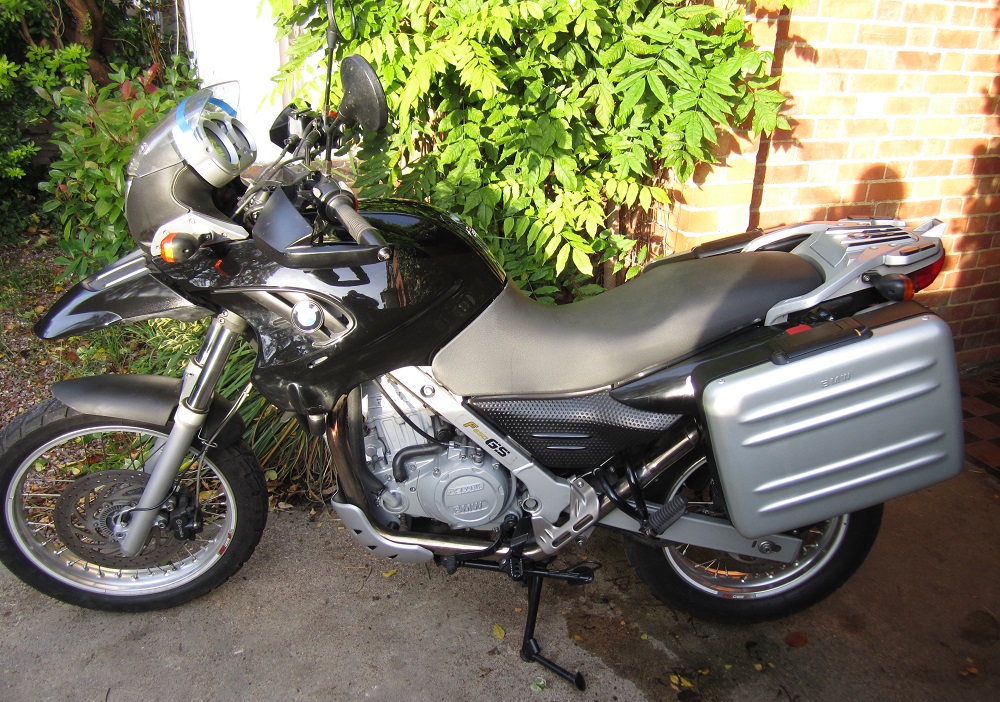Although I enjoy riding my Armstrong MT560, I decided to add a similar but more modern dual purpose motorcycle to my collection. I am not a great fan of Japanese bikes, in general, but I am fond of BMW bikes having owned a couple of boxer twins from new in the past. The BMW that I thought might satisfy my needs was the older single cylinder F650GS as opposed to the 2008 onwards F650GS which is, in fact, a 798 cc parallel twin.
The BMW F650 was a family of motorcycles first introduced in 1993 and the first single cylinder motorcycle from the company for 27 years. The original model produced between 1993-2000 for Europe was the F650ST Strada that was jointly designed by BMW and Aprilia using a carburettor based 652 cc 4-valve DOHC engine from the Austrian company Rotax. The bike was actually assembled by Aprilia. The Strada was basically a road bike with an 18″ front wheel and 17″ rear. However, in 1994, the F650 variant called the Funduro was introduced with more of a dual purpose capability with a 19″ front wheel. Both F650 models used a conventional petrol tank with the engine oil in the top of the frame.
These F650 models were replaced in 2000 by the true dual purpose F650GS (G = Gelände or terrain/off-road; S = Strasse or road) which came in a basic model like mine and a more off-road version called the Dakar. Whereas, my version has got a 19″ front wheel, the Dakar had a narrower 21″ front wheel as well as approximately 40 mm more suspension travel front and back. Otherwise, the two variants were the same with a 17″ rear wheel.
The F650GS used an uprated Rotax 652 cc engine with fuel injection to give much better fuel economy and also had a Nikasil lined cylinder for longer life. A catalytic converter was housed in the false left-hand silencer with the actual silencer being on the opposite side of the bike. A change was also made to house the fuel in a tank underneath the seat with the false tank now housing a separate oil tank, battery and air filter box. Over the lifetime of the F650GS, the main change in 2004 was to a dual spark version of the Rotax engine to improve fuel economy and to make its emissions EURO3 compliant. Although the engine was made in Austria, the bike was assembled in Germany.
In addition to the F650GS models, BMW also introduced the F650CS (City/Street) in 2001, also known as the Scarver, which remained in production until 2005. This was essentially a pure roadster version of the F650GS bike which was meant to appeal to non-traditional motorcycle riders and commuters with useful storage provided in the top of the false petrol tank. It used a toothed rubber belt for the final drive together and a single sided swinging arm and came with innovative styling features and colours. When introduced, the F650GS was BMW’s best selling bike worldwide but, in comparison, the F650CS was not a great success and did not sell that well.
The original F650GS was discontinued in 2007 and was replaced in the following year by a completely new design using a 798 cc twin engine although confusingly still called the F650GS. However, in 2008 the original single cylinder 652 cc engined model was resurrected as the G650GS with the bike assembled in Germany but with the engine now assembled in China and painted black. In 2012, a more off-road orientated version of the G650GS called the Sertao was launched which was very similar in design to the earlier Dakar. The G650GS did not sell that well and was eventually discontinued in 2016.
In summary, the 2000-2007 F650GS was a very popular dual purpose motorbike that sold extremely well but the earlier and later 652 cc variants were not that successful.
F650GS Design Features
The F650GS was configured as a dual purpose motorcycle with wide handlebars, monoshock rear suspension and high level exhaust system. In addition, the petrol tank was mounted below the seat which helps to keep the centre of gravity low. The bike was fitted as standard with a sump guard to protect the bottom of the engine.The Dakar version of the F650GS had more of an off-road bias with much greater front and rear suspension travel but was otherwise identical.
The 650 engine was designed and built by Rotax in Austria and is similar in overall configuration to the much earlier Rotax engine in my Armstrong MT650. The main difference is that the 650 engine is fuel injected and water cooled using a water pump mounted at the front of the left-hand clutch cover. The other main difference is that the 650 engine uses twin overhead camshafts to eliminate the need for valve rockers which are driven by a chain rather than a toothed belt as is the case in the single overhead camshaft Rotax 560 engine.
One of the features I liked about the F650GS was that it had a factory fit option of ABS braking on both wheels. This is achieved by using slotted disks and optical sensors on both wheels and an ABS pump mounted just behind the cylinder head into which the brake pipes are plumbed. Normally, the ABS is activated when the ignition is switched on but, for off-road use, the ABS is easily disabled using a switch in the middle of the handlebars.
The bike also comes fitted with heated handlebar grips with two heat settings helped in their effectiveness by the factory fitted handlebar hand protectors. For riding on cold days, I expect these features will keep my hands nice and warm which will certainly be a novelty for me!
My 2006 F650GS
Although the F650GS came in a variety of paint colours, including garish yellow, I have always had a liking for black painted bikes which included my Suzuki GSM1400 Final Edition. My F650GS was built in 2006 and therefore has the dual spark version of the 652 cc Rotax engine giving it a slightly better fuel economy but similar power and torque. In contrast with my MT560 which returns 53 mpg on a good day, my F650GS is returning a minimum of 65 mpg giving it a range of at least 250 miles on a tank of fuel which is very impressive!
I wanted a low mileage F650GS and the one I bought had only done 9,300 miles and had been looked after reasonably well with the last female owner having had it for about 7 years. Just before I collected the bike, it was given an MOT test and passed with flying colours. Unfortunately, the first test ride revealed some interesting handling problems which were quickly identified when I got back home as due to failing steering head bearings. This is a frequent problem with these bikes and has been put down to poor quality components originally used by BMW with case-hardened rather than through-hardened tapered roller bearings used. These suffer from a form of Brinelling damage to the lower cone, in particular, resulting in notchy steering. Fortunately, the bearings were easily replaced but I took care not to over tighten the new ones.
My original plan was to ride the F650GS in its present form and then to think about restoring it where necessary during the winter. However, I found that I could not to wait that long and decided instead to carry out restoration work as I went along. The main issues were that the black painted frame components were showing extensive signs of rust and a lot of the fasteners on the bike were also going rusty. In quite a few places, BMW had used stainless steel fasteners which had stood the test of time but the majority of zinc plated fasteners had not.
While the front forks were off to allow for the steering head bearings to be replaced, I overhauled the forks and repainted them using an aluminium coloured paint. I then removed the side and centre stands along with the foot pegs and mounting brackets and, after stripping them back to clean metal, re-sprayed them before refitting. I then decided to remove the black painted rear sub-frame which, conveniently, is only held on with four bolts. To detach it, I first had to remove the exhaust system and then, after removing a couple of mounting bolts from the back of the petrol tank, I was then able to withdraw the sub-frame backwards leaving the tank in place. The sub-frame was rusty in many places with a couple of the exposed mounting brackets being particularly bad. I would have liked to have got the sub-frame blasted and then powder coated but did not have the time and therefore cleaned it up by hand before re-spraying.
With the exhaust and sub-frame off the bike, I then removed the swinging arm and monoshock linkages in order to check their bearings and seals. With this type of needle bearing swinging arm arrangement, there is always a danger that the large retaining bolt may have rusted on to the bearing sleeves making it difficult to remove. This was the case with my Honda X250R which turned into a nightmare to solve and, in the end, required the use of an angle grinder to extract the swinging arm. Fortunately, in the case of my F650GS, the bolt came out without any problems. It has to be said that the swinging arm on this bike is one of the easiest I know to remove requiring only two bolts to be undone!
When I examined the monoshock linkage bearings, I found that they were all in good condition and only needed re-greasing to overhaul. However, the same could not be said of the swinging arm bearings. One side was ok but, on the other side, the needle bearings and sleeve or journal were rusted solid. Obviously, water had got in at some point and caused the damage. Exactly what was rotating when the swinging arm moved was very difficult to determine but it certainly was not the bearings on one side! With the failed bearings and seals replaced, the swinging arm and monoshock linkages were reinstalled with brand new bolts where necessary. This was followed by the rear sub-frame and exhaust system.
In addition to this work, other bits of remedial work have been carried out on the F650GS which included replacing the small LED indicators fitted when I bought the bike with the proper original type. I am now largely satisfied with the condition of the bike which is a lot smarter than it was and also gives me a great deal more confidence in it both mechanically and electrically.
Although I do not intend to go touring on the F650GS, it came with a very good quality BMW detachable top box along with Vario pannier boxes. The top box slides on to the rear carrier rack and the panniers hook on to the bars under the exhaust system and then snap on to studs just below the seat. The panniers are expandable and, with aluminium covers, perfectly match the style of the bike.
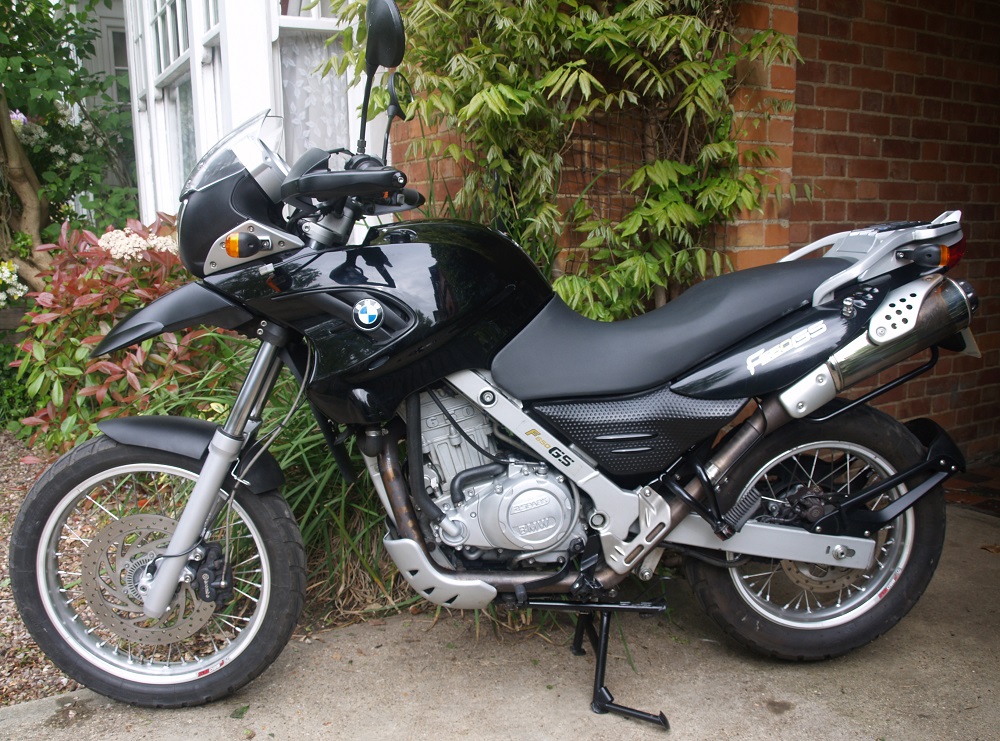
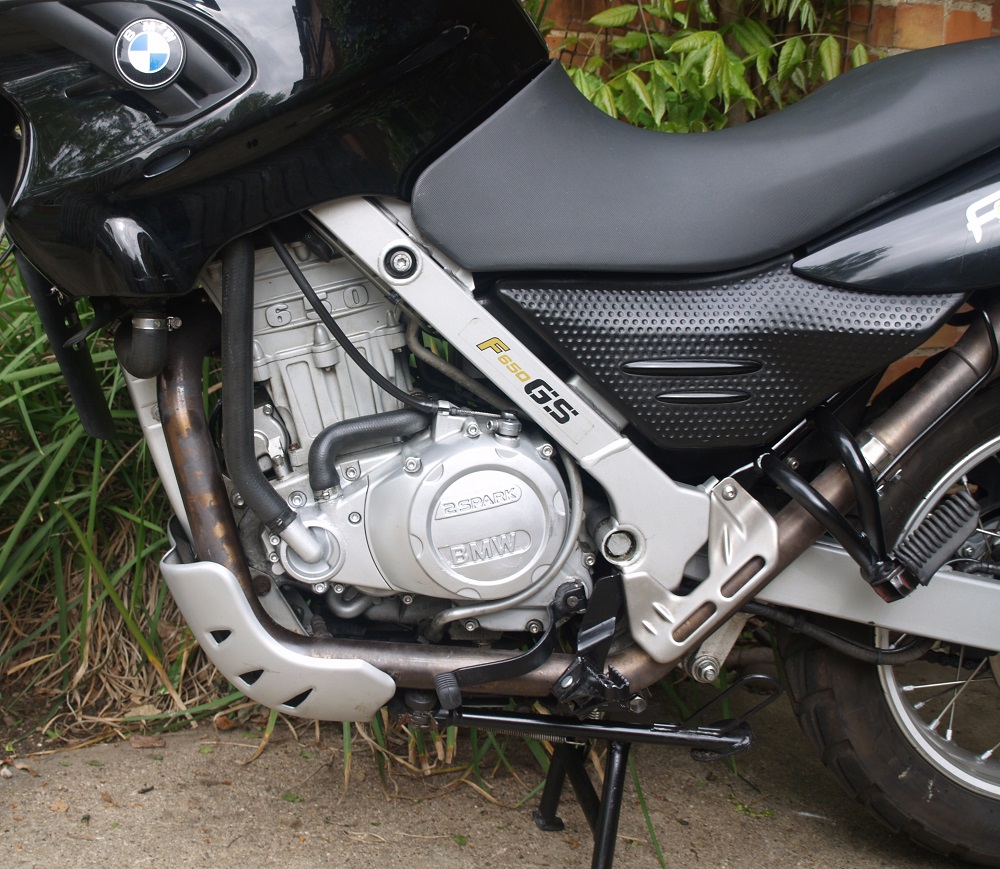
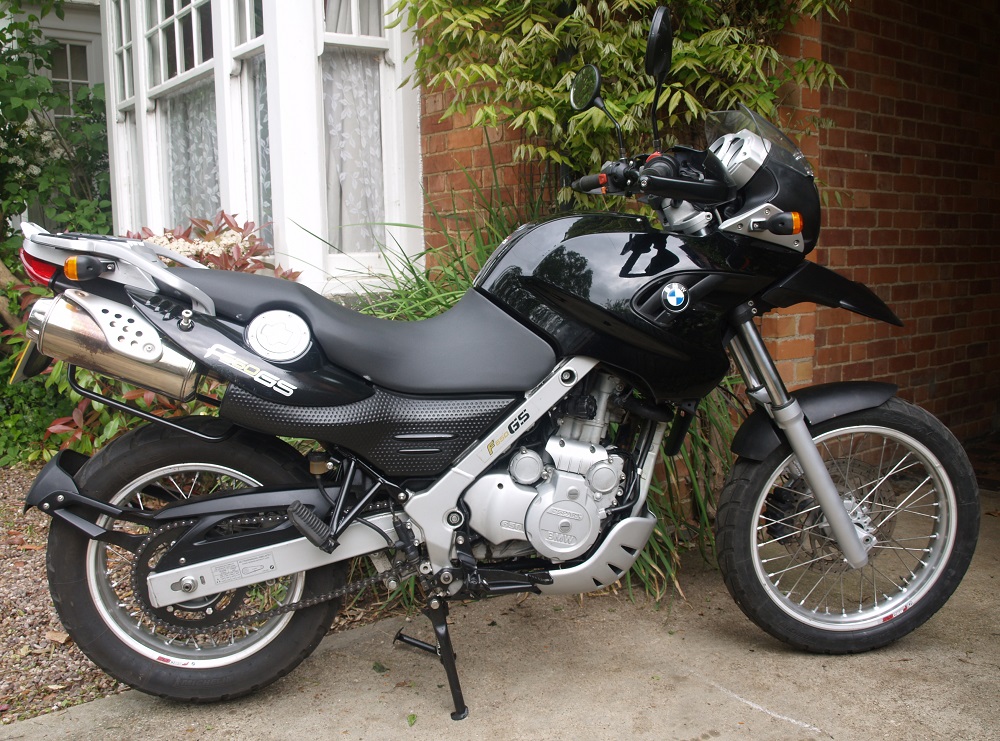
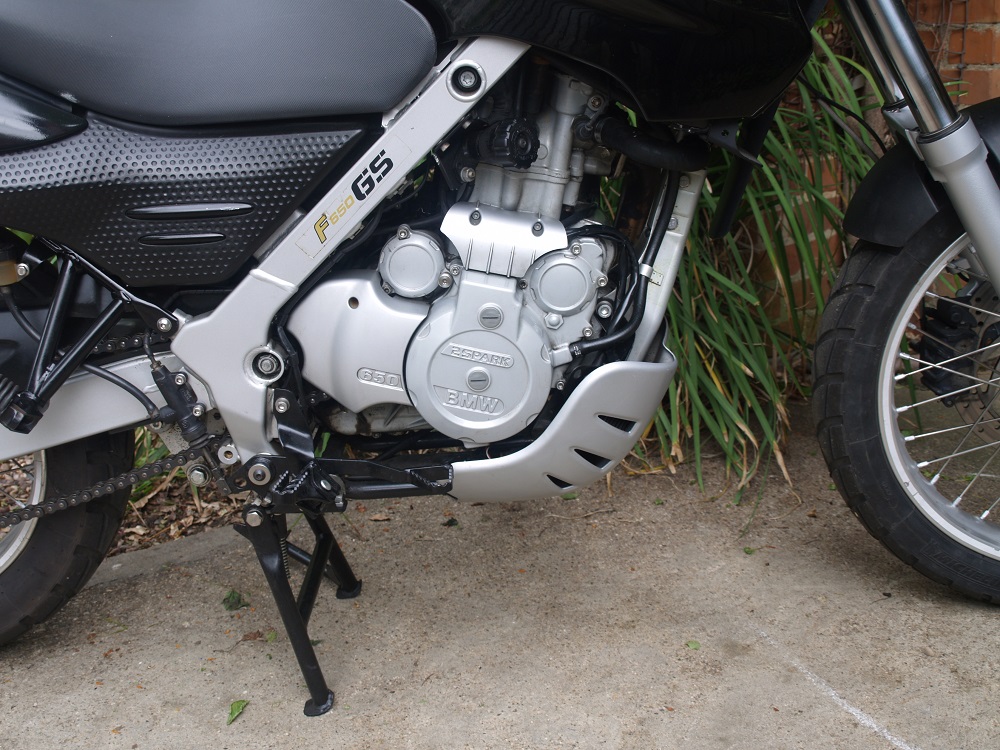
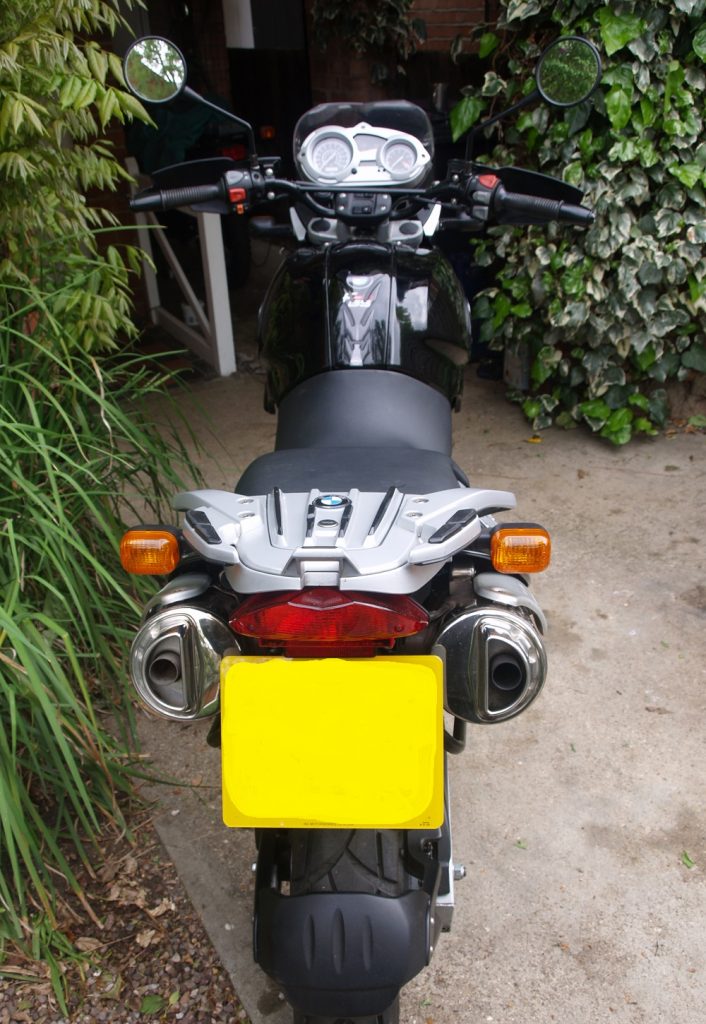
Restoration Phase 2
Having ridden the F650GS many miles since March 2019 without any problems, I decided it was time to complete its overall on the ramp in my workshop. One of the only issues I found with the bike was the strange gargling sound it makes when accelerated hard at lower revs which I assumed was not normal and was caused by an issue with the air intake or the exhaust.
However, the first job was to check the valve clearances and camchain which requires the air filter box, battery and carrier and oil tank to be removed first to get at the valve cover. Having removed the cover and moved the engine round to TDC on the compression stroke, all the valve clearances were measured to be well within spec. As far as I could see, the camchain and tensioner were also in good condition. While everything was apart, I took the opportunity to re-paint the battery carrier and replaced any rusting fasteners with new stainless steel ones.
However, having taken everything off the top of the engine including the fuel injector body, nothing was found amiss that could explain the gargling sound the engine had been making.
The next job was to overhaul the water pump since this was the only way of having confidence that it would not fail at some point especially after 13 years of life. Unfortunately, this requires taking off the clutch cover which is greatly hampered by the presence of the steel oil return pipe from under the engine which loops around the outside of the cover at the back. The oil pipe therefore needs to be disconnected at both ends and the exhaust pipe also has to be removed to allow the pipe to be moved out of the way.
The paint on the clutch cover and water pump covers was in poor condition and so was stripped off ready to be repainted. While this was being done, I decided to remove the front engine plate and the lower sub-frame to allow these to be re-painted along with the starter motor. Unfortunately, the front of the crankcases was badly furred up with aluminium oxide and this had to be removed with a rotary wire wheel and re-painted.
While the exhaust pipe was off, I attempted to clean off the brown covering using various chemical treatments none of which worked completely. I then found that I could polish off all the discolouring on my polishing wheel which more or less restored it to factory condition. Underneath what is basically heat induced corrosion, there was no blueing. Since the polishing process worked with the exhaust pipe, I decided to take off both silencers and give them the same treatment. The complete exhaust system now looks as good as new but it will be interesting to see how long it takes to go brown again?
With everything re-painted, I then reassembled everything which was straight forward except that I decided to mod the oil return pipe to make it easier to remove the clutch cover next time. This involved chopping it in half and adding a small length of rubber pipe in between. The coolant was replenished and 2.3 L of oil was poured into the header tank. I was expecting problems on starting the bike for the first time given the amount of work I done on the bike but it fired first time.
The only issue I had was that when I started the bike and looked to check oil was returning to the tank, the level in the tank dropped dramatically and no oil return could be seen. It appeared that the scavenge pump was not doing its job. However, after a lot of messing around, I decided there was nothing wrong. Unlike my MT560 where you can see the oil returning under the filler cap, the design of the F650GS oil tank makes it impossible to see the oil returning. Also, the drop in oil level is perfectly normal. Although I never realised it with the MT560, you need to wait until the engine oil has reached its working temperature before checking the oil level, preferably after a long ride. After a long ride, the oil level was at the MIN on the dip stick suggesting up to another 0.4 L oaf oil needs to be added.
I took the F650GS out for a quick test ride and then went out into the Chiltern Hills for my usual long ride. The bike performed much better than before because of the full service I’d given it and the strange gargling sound that has plagued the bike since I bought it in March has now disappeared. With all the work now carried out on the bike, while not fully restored like all my other bikes, it is now in good enough condition to suit my demanding requirements. I would now have total confidence in its reliability to take it anywhere.
BMW F650GS Performance
I was very interested to see how the F650GS compared with my MT560 with both having a single cylinder Rotax engine. The main performance difference between the two engines, apart from the difference in capacities, was that the F650GS has a 11.5:1 compression ratio and the MT560 has a 10.5:1 compression ratio. The theoretical maximum values for the engine torque is 60 Nm for the F650GS and 55 Nm for the MT560. On the road, the difference in performance is probably at the 10% level.
In terms of handling on the road, the MT560 appears to be much better possibly because of its use of high quality Marzocchi front forks and Ohlin rear shocks. I still have to tune the preload and rebound damping settings on the F650GS but, at the moment, the bike does not cope with road bumps as well as the MT560. However, the steering on the F650GS is much better with the MT560 appearing to be a bit light.
Where the F650GS has the advantage is in terms of braking. Both the drum brake on the rear of the MT560 and the corresponding disks on the F650GS are similar in performance. However, the larger diameter 300 mm disk on the front wheel of the F650GS gives it much greater braking performance compared with the 230 mm disk on the MT560. Of course, the F650GS also gains in principle from having ABS fitted.
The F650GS also has a significant advantage over the MT560 in terms of fuel economy. So far in riding the F650GS in the same way as the MT560, I am achieving about 76 mpg which, with a fuel capacity of 17.3 L, gives it an impressive range of over 280 miles. For any motorbike, this is truly amazing and makes long range touring something it would be very good at.
In terms of rider comfort, one of the advantages with the F650GS is that it provides a range of possible seat heights that will suit any rider. My MT560 seat height at 890 mm is ok for me. In contrast, my F650GS seat height is 820 mm and, although a little low, is still comfortable especially on the shorter journeys I normally take. The handlebar controls on my MT560 are very good and are essentially those from a Harley Davidson MT350. While the switch gear on the F650GS is of high quality, the control levers are a bit odd. The clutch lever is fitted with an adjustable reach but, slightly bizarrely, the front brake lever which needs it does not have an adjuster fitted, not even in the form of the adjuster screw fitted on the MT350. In other words, there is no way to adjust the reach of the front bake lever. If I can find one, I will eventually replace the brake lever with an adjustable one.
In summary, the BMW F650GS is a much more modern form of dual purpose motorcycle than the MT560 with a similar dry weight. The F650GS is slightly more powerful on the road but the overall riding experience is not that different either on the road or I am sure on green lanes. Where the F650GS has the advantage is that it uses a water cooled, fuel injected engine giving significantly better fuel economy and much greater range on a tank of fuel. It is the lack of range of the MT560 which is perhaps its greatest weakness and forces me to carry a 4L jerry can in one of the pannier bags! However, I will still continue to enjoy riding the MT560 because it retains its army heritage and is a more basic form of motorcycle like that provided by my other classic BSA and Triumph motorcycles.
Farewell to F650GS
In March 2020, I decided to buy a 2017 Triumph Tiger 800 XCa as my main adventure bike and therefore sold my BMW F650GS. I owned the F650GS for a little less than a year but really enjoyed riding it although it was, perhaps, a little too similar to my Armstrong MT560 to stand out fully. The good points were the bike’s ergonomics and low seat height and the truly amazing fuel consumption and tank range of over 250 miles. The downside was the quality of the cycle parts and the suspension and the somewhat harsh sound made by the engine especially on tick-over. In looking at a replacement for the F650GS, I considered the BMW F800GS but the main feature that ruled it out was the seat height which even for me at 5′ 10″ was a real challenge.
BMW F650GS Specifications
- Engine: Single cylinder, DOHC, 4-valve, 4-stroke
- Starting: Electric start only
- Capacity: 652 cc
- Bore/Stroke: 100 x 83 mm
- Compression Ratio: 11.5:1
- Max Power: 50 bhp
- Max Torque: 60 Nm
- Carburation: Fuel injection
- Cooling: Water cooled
- Lubrication: Dry sump
- Ignition: CDI with magnetic pick-up and twin sparks
- Transmission: 5 speed
- Final Drive: Chain
- Front Suspension: 41 mm telescopic fork with 170 mm travel
- Rear Suspension: Monoshock absorber with 165 mm travel
- Front Brake: 300 mm Brembo hydraulic single disc
- Rear Brake: 240 mm Brembo hydraulic disc
- Frame: Bridge type with bottom truss and bolt-on rear sub-frame
- Wheel Base: 1.500 m
- Seat Height: 780 mm
- Front Tyre: 100/90-19
- Rear Tyre: 130/80-17
- Ground Clearance: 146 mm
- Dry Weight: 176 kg
- Fuel Tank: 17.3 L
- Oil Tank: 2.3 L
BMW F650GS Parts Suppliers
The main source of spare parts for my F650GS has been Motorworks Ltd based in West Yorkshire who have provided an excellent service.
13,525 total views, 4 views today


